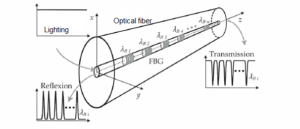 Researchers have been firstly created a fiber optic sensing system, known as a fiber Bragg grating (FBG), inside bio-soluble optical fibers. According to Science Daily, fiber optic technology can be used to monitor the condition of fractures and safely study sensitive organs, such as the brain.
Researchers have been firstly created a fiber optic sensing system, known as a fiber Bragg grating (FBG), inside bio-soluble optical fibers. According to Science Daily, fiber optic technology can be used to monitor the condition of fractures and safely study sensitive organs, such as the brain.
Fiber Bragg gratings that reflect the light of a particular wave are often applied in optical fibers used as distributed sensors. For example, such fibers are employed to monitor bridges in real-time or to track the integrity of aircraft wings. However, they have not yet been used in medicine. The new fiber technology will overcome these limitations by using optical fibers that break down in the body.
Firstly, researchers from Greece and Italy have created biodegradable glass for FBGs. They used phosphorus oxide in combination with oxides of calcium, magnesium, sodium, and silicon to perform this. The resulting optical glass combines excellent optical properties with water solubility and compatibility with living organisms, and its properties can be changed by adjusting the chemical composition.
Then the fiber Bragg gratings made from biodegradable glass were placed in conditions that are similar to the human body. As the experiment demonstrated, the created structures dissolve without a trace in such an environment, which opens the way for their medical application. Such FBG sensors are considered to be safe for the body and will not need to be removed after their use.
Possible examples of using optical fiber with FBGs include creating fiber optic sensors to assess joint pressure and monitor the heart and other sensitive organs. This optical fiber can also improve laser techniques for removing tumors by simultaneously conducting a laser beam and measuring temperature, necessary for the laser ablation process. Nevertheless, its safety and effectiveness will be tested on laboratory animals before developing medical applications of FBG technology.
Thus, a group of engineers from the University of Connecticut has created a biocompatible pressure sensor that will help doctors monitor chronic lung diseases, brain tumors, and other medical conditions, and then dissolve into the human body without a trace. Such a FBG sensor should replace existing implanted pressure sensors that are made up of potentially toxic substances and require removal after use.
Optromix is a manufacturer of innovative fiber optic products for the global market. The company provides the most technologically advanced fiber optic solutions for the clients. Optromix produces a wide range of fiber optic devices, including cutting-edge customized fiber optic Bragg grating product line and fiber Bragg grating sensor systems. Moreover, Optromix is a top choice among the manufacturers of fiber Bragg grating monitoring systems. If you have any questions, please contact us at info@optromix.com


 It is highly essential to have accurate spatial information of a medical device inside the patient for proper manipulation of the instrument. The thing is that a wide range of clinical applications requires spatial information. Nevertheless, each technique has its disadvantages, the promising solution is the application of
It is highly essential to have accurate spatial information of a medical device inside the patient for proper manipulation of the instrument. The thing is that a wide range of clinical applications requires spatial information. Nevertheless, each technique has its disadvantages, the promising solution is the application of  The application of
The application of Fiber optic technology
Fiber optic technology Tunnel fires are not regarded as usual, however, they also can perform great damage to lives and properties if they take place. The process of fire detection inside the lengthy and curved tunnel is challenging. Nevertheless,
Tunnel fires are not regarded as usual, however, they also can perform great damage to lives and properties if they take place. The process of fire detection inside the lengthy and curved tunnel is challenging. Nevertheless, An electrical engineer from the Netherlands has developed a
An electrical engineer from the Netherlands has developed a  A team of researchers from the U.S. continues developing a
A team of researchers from the U.S. continues developing a  A new compact
A new compact  A team of researchers offers a new application of
A team of researchers offers a new application of The opportunity to measure body temperature plays a crucial role in both physiological studies and clinical investigations. New wearable sensors based on
The opportunity to measure body temperature plays a crucial role in both physiological studies and clinical investigations. New wearable sensors based on